Magnification Study guides, Class notes & Summaries
Looking for the best study guides, study notes and summaries about Magnification? On this page you'll find 3340 study documents about Magnification.
Page 4 out of 3.340 results
Sort by
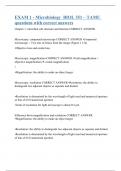
-
EXAM 1 - Microbiology BIOL 351 – TAMU questions with correct answers
- Exam (elaborations) • 52 pages • 2023
- Available in package deal
-
- $14.99
- + learn more
Chapter 1: microbial cell structure and function CORRECT ANSWER Microscopy: compound microscope CORRECT ANSWER •Compound microscope -- Two sets of lenses form the image (Figure 1.15a) •Objective lens and ocular lens Microscopy: magnification CORRECT ANSWER •Total magnification = objective magnification ocular magnification • •Magnification: the ability to make an object larger Microscopy: resolution CORRECT ANSWER •Resolution: the ability to distinguish two adjacent obj...
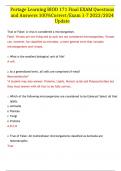 Popular
Popular
-
BIOD 171 Portage Learning Final EXAM Questions and Answers 100%Correct/Exam 1-7 2023/2024 Update
- Exam (elaborations) • 44 pages • 2023
-
- $20.99
- 4x sold
- + learn more
BIOD 171 Portage Learning Final EXAM Questions and Answers 100%Correct/Exam 1-7 2023/2024 UpdatePortage Learning BIOD 171 Final EXAM Questions and Answers 100%Correct/Exam 1-7 2023/2024 Update True or False: A virus is considered a microorganism. False. Viruses are not living and as such are not considered microorganisms. Viruses can, however, be classified as microbes, a more general term that includes microorganisms and viruses. 1. What is the smallest biological unit of life? A cell. ...
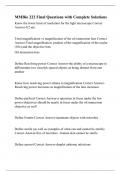
-
MMBio 222 Final Questions with Complete Solutions
- Exam (elaborations) • 18 pages • 2024
-
- $13.99
- + learn more
Know the lower limit of resolution for the light microscope Correct Answer-0.2 um Total magnification vs magnification of the oil immersion lens Correct Answer-Total magnification: product of the magnification of the ocular (10x) and the objective lens Oil immersion lens Define Resolving power Correct Answer-the ability of a microscope to differentiate two closelyk spaced objects as being distinct from one another Know how resolving power relates to magnification Correct Answer-Resolvi...
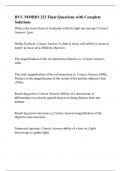
-
BYU MMBIO 222 Final Questions with Complete Solutions
- Exam (elaborations) • 18 pages • 2024
-
- $15.49
- + learn more
What is the lower limit of resolution with the light microscope? Correct Answer-.2µm Define Parfocal: Correct Answer-A slide in focus will still be in focus to nearly in focus on a different objective. The magnification of the oil immersion objective is: Correct Answer-100x The total magnification of the oil immersion is: Correct Answer-1000x, Product of the magnification of the ocular (10x) and the objective lens (100x). Resolving power: Correct Answer-Ability of a microscope to di...
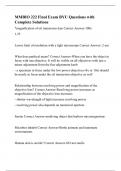
-
MMBIO 222 Final Exam BYU Questions with Complete Solutions
- Exam (elaborations) • 23 pages • 2024
-
- $15.49
- + learn more
*magnification of oil immersion lens Correct Answer-100x 1.25 Lower limit of resolution with a light microscope Correct Answer-.2 um What does parfocal mean? Correct Answer-When you have the object in focus with one objective. It will be visible on all objectives with just a minor adjustment from the fine adjustment knob - a specimen in focus under the low power objectives (4x or 10x) should be nearly in focus under the oil immersion objective as well Relationship between resolving po...
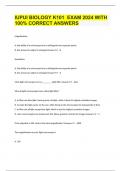
-
IUPUI Biology K101 exam 2024 with 100% correct answers
- Exam (elaborations) • 37 pages • 2024
-
- $15.99
- + learn more
Magnification: A. the ability of a microscope lens to distinguish two separate points B. the amount an object is enlarged Answer - B Resolution: A. the ability of a microscope lens to distinguish two separate points B. the amount an object is enlarged Answer - A Most light microscopes carry a ________ light filter Answer - blue Why do light microscopes have a blue light filter? A. to filter out blue light, leaving more red light, which is best for highest resolution images ...
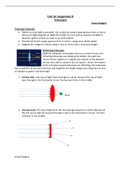
-
Unit 16 Assignment B
- Summary • 18 pages • 2022
-
Available in package deal
-
- $10.46
- 11x sold
- + learn more
Unit 16 Assignment B Overall Grade: Distinction Course Overall Grade: D*D Contains: telescopes. lenses, investigation notes, risk assessments, magnification equations, problems with telescopes, mirrors, concave, convex, resolving power, arrays, earth based telescopes, space based telescopes, atmosphere, space telescope examples, Hubble, James Webb, Spitzer, X-Ray, Newton, NASA, collaborations between nations, star observations, Orion, Ursa Major, Cygnus, Cassiopeia, Andromeda, Ecliptic ...
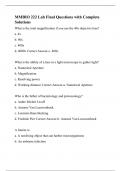
-
MMBIO 222 Lab Final Questions with Complete Solutions
- Exam (elaborations) • 20 pages • 2024
-
- $15.49
- + learn more
What is the total magnification if you use the 40x objective lens? a. 4x b. 40x c. 400x d. 4000x Correct Answer-c. 400x What is the ability of a lens in a light microscope to gather light? a. Numerical Aperture b. Magnification c. Resolving power d. Working distance Correct Answer-a. Numerical Aperture Who is the father of bacteriology and protozoology? a. Andre Michel Lwoff b. Antonie Van Leeuwenhoek c. Lourrens Baas Becking d. Fredrick Pier Correct Answer-b. Antonie Van Le...
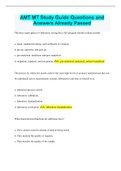
-
AMT MT Study Guide Questions and Answers Already Passed
- Exam (elaborations) • 196 pages • 2022
-
Available in package deal
-
- $10.49
- 1x sold
- + learn more
AMT MT Study Guide Questions and Answers Already Passed The three major phases of laboratory testing that a QA program should evaluate include a. mean, standard deviation, and coefficient of variation. b. pre-op, operative, and post-op. c. pre-analytical, analytical, and post-analytical. d. outpatient, inpatient, and non-patient. c. pre-analytical, analytical, and post-analytical. The process by which test results achieve the same high levels of accuracy and precision that can be reproduced...
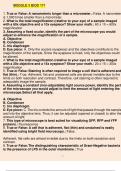
-
Module 3 BIOD 171 1. True or False: A nanometeris longer than a micrometer.: False. A nanometer is 1,000 times smaller than a micrometer. 2. What is the total magnification (relative to your eye) of a sample imaged with a 60x objective and a 10x eyepiece?
- Exam (elaborations) • 2 pages • 2023
-
- $10.49
- + learn more
Module 3 BIOD 171 1. True or False: A nanometeris longer than a micrometer.: False. A nanometer is 1,000 times smaller than a micrometer. 2. What is the total magnification (relative to your eye) of a sample imaged with a 60x objective and a 10x eyepiece? Show your math.: 60 x 10 = 600x magnification 3. Assuming a fixed ocular, identify the part of the microscope you would adjust to enhance the magnification of a sample. A. Objective B. Condenser C. Iris diaphragm D. Eye piece: A. Onl...



